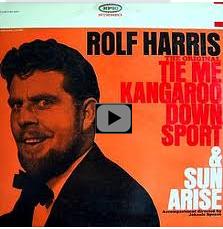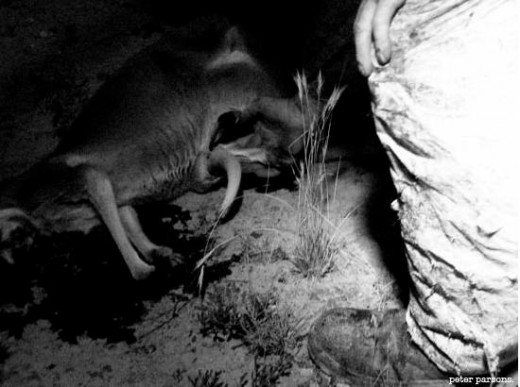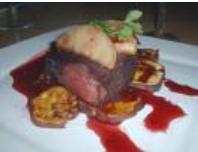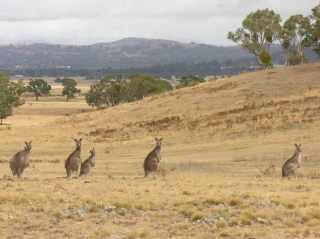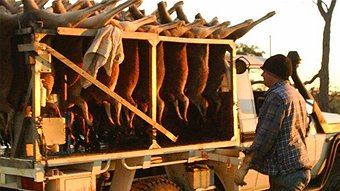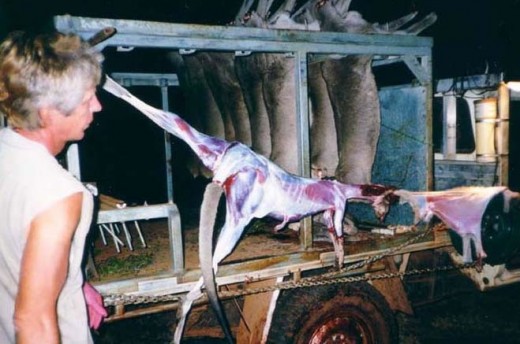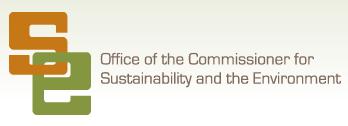Kangaroo rapers and the E.coli time bomb
Tuesday, October 25th, 2011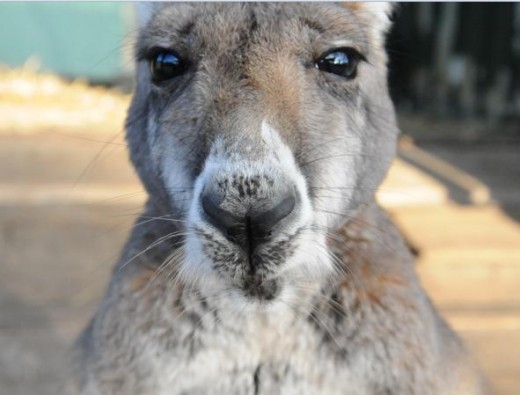 Australia’s native kangaroo – targeted by poachers and mass slaughter encouraged by Australian governments
Australia’s native kangaroo – targeted by poachers and mass slaughter encouraged by Australian governments
.
The Australian outback town of Mitchell lies in the Western Downs region of southern Queensland on the Warrego Highway just shy of 600 km west of Brisbane on the way to Charleville. Situated on the Maranoa River, the town of Mitchell was named in honour of the 19th Century explorer, and the town emerged as a pastoral town out of the farming of grains, beef and sheep. Tourism has become a strong drawcard to Mitchell and especially to its Great Artesian Spa.
But more recently, Mitchell’s fame has been lowered to infamy with it taking on a reputation for becoming the home of the kangaroo slaughter trade.
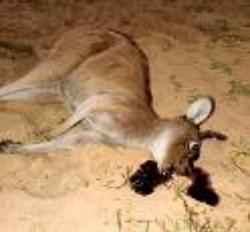 .
.
“You see a lot of utes in Mitchell and the towns just like it that emerge from the roadside only to disappear again as you drive west through southern Queensland on the Warrego Highway. You can tell the ones that are driven by kangaroo shooters. They have racks for guns and long spikes upon which the freshly eviscerated carcasses are placed. One, parked just around the corner, has black steel bullbars with the words “roo raper” cut into them.”
.
‘Besides the slaughter of Australia’s iconic kangaroos for pet meat and indeed export for human consumption in fancy restaurant,
it is the sanitary conditions that is shocking and a life threatening time bomb’
.
Following the international biolab standards of Silliker, animal liberation chief, Mark Pearson says “the last time we did swabs here and in Charleville, they were alarmingly high in E.coli.“
‘The chiller doors aren’t locked. When Ben-Ami opens the first, problems are immediately apparent. Bright drips from fresh kills are spotting onto another layer of older, duller, deader blood, which is particularly thick nearest the front. The lip of the door frame is so thick and sticky, the red’s turned a dull, dark brown. Hairs are stuck to it.
.
‘The carcasses are packed as tightly as possible.
They hang from hooks by their legs,
their heads and tails missing,
gaping rents where their stomachs once were,
leg muscles tensed visibly;
severed necks poke into gut cavities;
hundreds of paws hang in a grisly reach towards the bloody floor.
According to their tags,
they’re four days dead.’
“These are quite young ones, heads cut off quite low,” Pearson says, pointing to a nub of spine that’s jutting out just above the shoulder.
“Most of them are cut too far back.” To decapitate in this way requires significantly more effort than using the traditional method, with a slice directly beloiw the jawline. It also makes bad financial sense to remove most of the neck , as harvesters are paid by weight. Proof, claim the activists, that an illegal shot in the jaw or neck has been covered up.
‘Pearson points to the floor. “They’re bringing in new carcasses and hanging them above the floor, which has blood from old carcasses. Blood is a Petri dish for disease and contamination. This is a major breach of any export abattoir standards.” he points to a small grey kangaroo that is caked elbow to paw in blood and dirt. “That’s from the evisceration,” he says. That’s all supposed to fall to the ground. And don’t forget, these would have been on the back [of a ute] for four, five, six hours, and it would have been 20 degrees. When you consider this is export meat…Uh-oh…”
Besides Mitchell, the roo rapers store their roo chillers at Charleville, Augathella and Blackall. The practice in outback Queensland is widespread.
To struggling towns in the outback like Mitchell, kangaroo meat is big business. “The Kangaroo Industry Industry Association of Australia says theirs is a business worth $270 million a year that directly employs about 4000 people” many in remote areas.”
[Source: Sydney Morning Herald, Good Weekend magazine, 20090523].
AusHunt, a website dedicated to hunting in Australia and it’s hunters, advocates:
.
“Kangaroo shooting is a unique job and many people are involved in one way or another in Australia’s kangaroo industry. My advice for the wannabe ‘roo shooter? You’ll need to make a few phone calls to chiller-box operators in various rural centers to evaluate the impact another ‘roo shooter would have there. Then decide on a location.
Before doing anything, take a week off work and go out with a qualified, professional ‘roo shooter and see what is actually involved.
Australia’s kangaroo industry is one of the only jobs in the world where a person can legally shoot wild animals full-time for a living.
Kangaroo shooting is a tough life with long hours, and a certain danger element. Depending on weather conditions (wind, rain), phases of the moon and drought, the kangaroo shooter may have a good or bad night. It can be a very irregular income earner.
Many shooters struggle to make money, some make a living, and a few make good profits of A$100,000/annum +. Dedication is the name of the game …. going out night after night and avoiding the temptations of the local pub. The upside is that the shooter is very independent and can lead an exciting outdoors life, totally using his wits, determination and shooting prowess to make money.
Okay, you like what you see and you’ve done your courses. Move to the rural center that you have selected and get a day job there, whether it be pumping gas or whatever. Then, start looking around for properties on which to shoot and start off by shooting week-ends. See how you go, then move on to fulltime when you know that you can make money. Good luck!”
.
.
‘Kangaroo harvesting under the spotlight’
.
Animal welfare activists are hoping public outrage over the slaughter of cattle in Indonesia can be redirected towards a new target – the commercial harvest of kangaroos. But activists’ involvement with research at the University of Technology, Sydney (UTS), has sparked a major scientific blue.
A year ago, animal welfare group Voiceless established THINKK at UTS, specifically to oppose the commercial kangaroo harvest. The unit’s lead scientist, ecologist Dr Dror Ben-Ami, says a lot of information about the kangaroo industry is misrepresented and not researched thoroughly.
This year, the national quota for the commercial harvest of kangaroos is set at around 3.7 million animals, but Dr Ben-Ami fears the real toll may be much higher.
“We estimate that up to a million dependent young are killed inhumanely every year as a result of the kangaroo industry,” he said.
“Those numbers come from industry statistics, in the sense of how many females are killed every year, and from behavioural reproductive ecology knowledge about how many young each female will have.”
There are in fact no industry figures on how many joeys are killed. Their main protection is the commercial shooters licence, which bans the hunting of females with dependent young.
Professor Mike Archer, the dean of science at the University of New South Wales (UNSW), says shooters are aware female kangaroos may be carrying joeys.
“There is an effort made by the shooters. They’re aware of this issue,” he said. He has raised questions about the research being done by THINKK.
“If a group like that were actually based in my university, in the University of New South Wales, we would be having a very serious think about whether they actually belong there,” he said.
“If they publish their own papers, refereed their papers themselves, didn’t quote real experts in the field, we would be very uncomfortable if they were operating in UNSW.”
.
Hygiene fears
.
Adult kangaroos are shot by night and driven to chillers the next day for processing, leading to another of THINKK’s major concerns – the hygiene of the meat.
In early 2009, Animal Liberation collected samples from unlocked outback chillers, which tested positive for E. coli and salmonella. Several months later, major export destination Russia slapped a ban on kangaroo meat, citing contamination fears.
“If one ate kangaroo meat with high levels of E. coli, you’d have a upset stomach – that would be the case with most people,” Dr Ben-Ami said.
Animal Liberation went on to set up new lab tests of supermarket meat. Dr Ben-Ami says the findings are concerning.
“The results have shown very high levels of E. coli, above alert levels of 1,000 colony-forming units and also a couple of samples came back positive for salmonella,” he said.
There are hundreds of different kinds of E. coli, but only some can be toxic. Animal Liberation’s tests did not establish whether the E. coli found in the kangaroo meat was dangerous.
But UNSW researcher Rosie Cooney says Dr Ben-Ami’s concerns about the contamination of kangaroo meat are overstated.
“A large study done some years ago that looked at over 200,000 carcasses found in fact that the rates of rejection for contamination of kangaroo carcasses were actually considerably less than those for sheep,” she said.
Science ‘under siege’
Dr Cooney and her colleagues believe when it comes to the commercial harvest of kangaroos, the science is now under siege. This has spurred them into action, with a national group of scientists about to publish a critique of THINKK’s claims.
This group says the research proves there is great environmental benefit in encouraging farmers to harvest kangaroos for profit.
“They’re then going to want to value those animals, keep them on their land and importantly, maintain the habitat, the native vegetation, for those creatures as well,” she said.
Dr Ben-Ami says his critics should “write back and engage in academic dialogue, rather than smearing”.
THINKK has today released a new paper arguing against the kangaroo harvest on animal welfare grounds. Their key claim is that that shooters are missing the mark and joeys are being left to die.
[Read Paper]“We’re taking a native animal out of its natural habitat in great numbers every year and thinking that that has no ramifications, and I think that’s absurd,” he said.
With both sides claiming the science is on their side, the challenge for animal welfare groups is to get kangaroos off the menu.
..
[Source: ‘Welfare Activists Target Kangaroo Industry‘, by Sarah Dingle and staff, 20110713, ABC Western Queensland, ^http://www.abc.net.au/news/2011-07-13/welfare-activists-target-kangaroo-industry/2793878/?site=westqld, accessed 20111025].
.
Would you eat this animal?
.Natural resources are at the heart of the booming Australian economy. In particular, the country’s success in selling these economic growth goodies to a ravenous China has transformed the Aussie economy.
China is today Australia’s largest trading partner, buying up iron ore, coal, natural gas, and other industrial minerals to the tune of $55.2 billion a year — or more than 20 percent of Australia’s total exports. So it’s not too surprising that some entrepreneurial Australians want to add another natural resource to that growing list: kangaroo meat. Australia is crawling with the creatures. And China is apparently hungry for them.That’s the plan, anyway, according to this fine feature story from Matt Siegel in the New York Times.“The Chinese have a strong culinary tradition in using wild foods, not just meat, but a wide range of wild foods called yaemei in Cantonese and yewei in Mandarin,” John Kelly, executive director of the Kangaroo Industry Association of Australia, a lobbying group, told Siegel. “Kangaroo will to a large extent just slot right into that existing tradition in much the same way it has in the European markets.”China sent a government delegation to Australia last December to investigate the health and sanitary conditions of kangaroo producers, the New York Times reports.
And not without reason. Kangaroo meat has come under increasing scrutiny following an E. coli outbreak in 2009, which led to a ban from kangaroo-scarfing Russia. The health scare also triggered a collapse of kangaroo meat exports, which tumbled from $38.4 million in 2008 to just $12.3 million last year.
But the new plan to sell kanga-meat to China comes with other challenges. First off, kanga meat is a hard sell — even to Australians. According to a 2008 study cited by the New York Times, just 14.5 percent of Australians have “knowingly” eaten kangaroo meat, versus the 80 percent who eat beef.
The problem? Kangaroo meat has been commonly used as pet food and as skins for clothing. Moreover, many Aussies view the country’s 25 million roos —who outnumber the 23 million human Australians — as large, destructive, and sometimes dangerous pests.
But the bigger challenge might be taste.
“It’s gamey — think beef plus arm pit,” says Freya Petersen, GlobalPost’s Breaking News Editor and our resident Australian staffer. “It needs to be cooked through but not over-cooked.”
“To me, it smells like pet food because we used to feed it to our dog and cat,” she adds.
Environmentalists and animal rights groups are also worried about the plan.
Australia’s kangaroo population “can’t even deal with the domestic and European consumption,” Nikki Sutterby of the Australian Society for Kangaroos told the New York Times. “How would it deal with a country as large as China starting to eat kangaroo meat?”
The kanga-meat crowd down under, however, remains undeterred.
“I’d expect us to be putting product into China at some time this year,” Kelly told the New York Times, adding that he expected China “at some stage to be a larger market than Russia ever was.”
.
[Source: ‘Would you eat thsi animal?’, by Thomas Mucha, 20110415, ^http://www.globalpost.com/dispatches/globalpost-blogs/macro/kangaroo-australia-china].
.
‘It sure ain’t Easy being Green! About the Kangaroo Coalition coordinator!’
by John Watson, Spectator News Magazine
.
‘Pat O’Brien became a greenie, and activist, in Condobolin 35 years ago when he saw kangaroos herded together, shot and clubbed to death. Until that moment, he had been “normal”.
The meatworker, who was working his way around Australia with his wife and three kids, did not think about the environment, probably dropped paper on the ground and just lived his own life. However, because of that sight of kangaroos being slaughtered, he has spent the next 35 years fighting for animals and the environment….’
READ MORE: ^http://www.kangaroo-protection-coalition.com/coordinator.html
.
Meanwhile, the Queensland Government tries to legitimise wildlife poaching by using euphemistic language…’The Department’s Commercial Macropod Management Program administers the commerical harvest of macropods in Queensland.’
.
‘It’s a poor farm that can’t sustain a few kangaroos.’
.
.
Further Reading:
.
[1] ‘A Shot in the Dark‘, ^http://www.wildlifeadvocate.com/pdf/a_shot_in_the_dark.pdf , [Read Report] [2] National Kangaroo Protection Coalition, ^http://www.kangaroo-protection-coalition.com/ [3] THINKK (The Think Tank for Kangaroos), University of Technology Sydney, ^http://thinkkangaroos.uts.edu.au/ [4] No Kangaroo Meat website, ^http://www.nokangaroomeat.org/ [5] ‘Kangaroo Harvesting under the spotlight‘, ABC TV ‘730 Programme’, 20110713, ^http://www.abc.net.au/7.30/content/2011/s3268904.htm [6] Australian Society For Kangaroos, ^http://www.australiansocietyforkangaroos.com/not_so_green.html [7] Read the original comments to the initial article by Tigerquoll on the CanDoBetter.net website: ‘Kangaroo rapers of Mitchell (Qld) and the E.coli time bomb‘